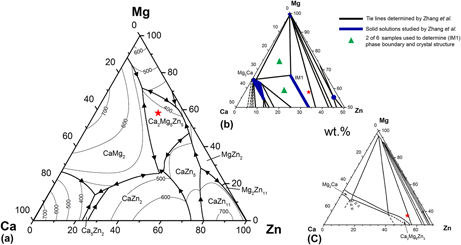Crossref Citations
This article has been cited by the following publications. This list is generated based on data provided by
Crossref.
Naghdali, Saeedeh
Jafari, Hassan
and
Malekan, Mehdi
2018.
Cooling curve thermal analysis and microstructure characterization of Mg-5Zn-1Y-xCa (0–1 wt%) alloys.
Thermochimica Acta,
Vol. 667,
Issue. ,
p.
50.
Li, Hong-xiang
Qin, Shi-kai
Ma, Ying-zhong
Wang, Jian
Liu, Yun-jin
and
Zhang, Ji-shan
2018.
Effects of Zn content on the microstructure and the mechanical and corrosion properties of as-cast low-alloyed Mg–Zn–Ca alloys.
International Journal of Minerals, Metallurgy, and Materials,
Vol. 25,
Issue. 7,
p.
800.
Köhler, Katharina
and
Röhr, Caroline
2019.
Zn‐rich Zincides of the Ternary System Ca–Mg–Zn: Synthesis, Crystal structure, Chemical Bonding.
Zeitschrift für anorganische und allgemeine Chemie,
Vol. 645,
Issue. 3,
p.
219.
Ojdanic, Andrea
Horky, Jelena
Mingler, Bernhard
Fanetti, Mattia
Gardonio, Sandra
Valant, Matjaz
Sulkowski, Bartosz
Schafler, Erhard
Orlov, Dmytro
and
J. Zehetbauer, Michael
2020.
The Effects of Severe Plastic Deformation and/or Thermal Treatment on the Mechanical Properties of Biodegradable Mg-Alloys.
Metals,
Vol. 10,
Issue. 8,
p.
1064.
Zander, Daniela
Zaslansky, Paul
Zumdick, Naemi A.
Felten, Markus
Schnatterer, Christian
Chaineux, Veronika F.
Hammel, Jörg U.
Storm, Malte
Wilde, Fabian
and
Fleck, Claudia
2021.
The Effect of Chemistry and 3D Microstructural Architecture on Corrosion of Biodegradable Mg–Ca–Zn Alloys.
Advanced Engineering Materials,
Vol. 23,
Issue. 11,
Iranshahi, Fatemeh
Nasiri, Mohammad Bagher
Warchomicka, Fernando Gustavo
and
Sommitsch, Christof
2022.
Investigation of the degradation rate of electron beam processed and friction stir processed biocompatible ZKX50 magnesium alloy.
Journal of Magnesium and Alloys,
Vol. 10,
Issue. 3,
p.
707.
Yan, H.
Shao, X.H.
Li, H.P.
Chen, R.S.
Cui, H.Z.
and
Han, En-Hou
2022.
Synergization of ductility and yield strength in a dilute quaternary Mg-Zn-Gd-Ca alloy through texture modification and Guinier–Preston zone.
Scripta Materialia,
Vol. 207,
Issue. ,
p.
114257.
Schäublin, R.E.
Becker, M.
Cihova, M.
Gerstl, S.S.A.
Deiana, D.
Hébert, C.
Pogatscher, S.
Uggowitzer, P.J.
and
Löffler, J.F.
2022.
Precipitation in lean Mg–Zn–Ca alloys.
Acta Materialia,
Vol. 239,
Issue. ,
p.
118223.
Li, Z.H.
Cheng, D.
Wang, K.
Hoglund, E.R.
Howe, J.M.
Zhou, B.C.
Sasaki, T.T.
Ohkubo, T.
and
Hono, K.
2023.
Revisited precipitation process in dilute Mg-Ca-Zn alloys.
Acta Materialia,
Vol. 257,
Issue. ,
p.
119072.
Hagihara, Koji
Shakudo, Shuhei
Tokunaga, Toko
and
Nakano, Takayoshi
2023.
Development of Zn–Mg–Ca Biodegradable Dual-Phase Alloys.
Metals,
Vol. 13,
Issue. 6,
p.
1095.
Wu, Xinhe
Jiang, Quantong
Geng, Yahui
Liu, Nazhen
Li, Mei
Duan, Jizhou
and
Hou, Baorong
2024.
The microstructure and corrosion resistance of Mg–Zn-0.5Ag-xCa (x=0, 0.5, 1.0, 1.5 wt%) alloys in Hank's solution.
Journal of Materials Research and Technology,
Vol. 30,
Issue. ,
p.
5869.
Devikar, Akshay
Yadav, Soumith
Mukherjee, Manas
and
Kumar, G. S. Vinod
2024.
Effect of Zn on the Structure and Mechanical Properties of Mg-Ca Foams.
Metallurgical and Materials Transactions B,
Vol. 55,
Issue. 6,
p.
5023.
Bairagi, Darothi
Mandal, Santanu
Roy, Mangal
Paliwal, Manas
and
Mandal, Sumantra
2024.
Enhanced in-vitro degradation resistance and cytocompatibility of a thermomechanically processed novel Mg alloy: Insights into the role of microstructural attributes.
Journal of Magnesium and Alloys,
Vol. 12,
Issue. 2,
p.
700.
Dyakonov, G. S.
Vorobiev, E. V.
and
Miftakhov, D. T.
2024.
Effect of homogenization annealing and equal channel angular pressing on the microstructure and mechanical properties of magnesium alloy Mg-1Zn-0.15Ca.
Russian Physics Journal,
Vol. 67,
Issue. 12,
p.
2241.
